Spatial Heterogeneity of Factors Influencing CO2 Emissions in China’s High-Energy-Intensive Industries
Abstract
:1. Introduction
2. Data Sources and Methods
2.1. Data Sources and Description
2.2. Study Methods
3. Results
3.1. Temporal and Spatial Heterogeneity of CEs
3.2. Spatial Autocorrelation Analysis of CEs in HEI Industries
3.3. Evaluating All Possible Combinations of the Candidate Explanatory Variables
3.4. Estimation Results of the GWR Model
4. Discussion
4.1. The Effect of the Industrial Structure on CO2 Emissions
4.2. The Effect of the Per Capita GDP on CO2 Emissions
4.3. The Effect of the Technological Progress on CO2 Emissions
4.4. The Effect of the Population on CO2 Emissions
4.5. The Effect of the Foreign Direct Investment on CO2 Emissions
5. Conclusions and Policy Implications
Author Contributions
Funding
Institutional Review Board Statement
Informed Consent Statement
Data Availability Statement
Acknowledgments
Conflicts of Interest
References
- Davis, S.J.; Caldeira, K.; Matthews, H.D. Future CO2 emissions and climate change from existing energy infrastructure. Science 2010, 329, 1330. [Google Scholar] [CrossRef] [Green Version]
- Ma, X.J.; Wang, C.X.; Dong, B.Y.; Gu, G.C.; Chen, R.M.; Li, Y.F.; Zou, H.F.; Zhang, W.F.; Li, Q.N. Carbon emissions from energy consumption in China: Its measurement and driving factors. Sci. Total Environ. 2019, 648, 1411–1420. [Google Scholar] [CrossRef]
- Liddle, B. What are the carbon emissions elasticities for income and population? Bridging STIRPAT and EKC via robust heterogeneous panel estimates. Glob. Environ. Chang. 2015, 31, 62–73. [Google Scholar] [CrossRef] [Green Version]
- Shen, K.T.; Gong, J.J. Environmental Pollution, technical Progress and productivity growth of energy-intensive industries in China-empirical study based on ETFP(in Chinese). China Ind. Econ. 2011, 12, 25–34. [Google Scholar] [CrossRef]
- Franco, S.; Mandla, V.R.; Ram Mohan Rao, K. Urbanization, energy consumption and emissions in the Indian context A review. Renew. Sustain. Energy Rev. 2017, 71, 898–907. [Google Scholar] [CrossRef]
- Bai, Y.P.; Deng, X.Z.; Gibson, J.; Zhao, Z.; Xu, H. How does urbanization affect residential CO2 emissions? An analysis on urban agglomerations of China. J. Clean. Prod. 2019, 209, 876–885. [Google Scholar] [CrossRef]
- Yin, G.Y.; Lin, Z.L.; Jiang, X.L.; Yan, H.W.; Wang, X.M. Spatiotemporal differentiations of arable land use intensity—A comparative study of two typical grain producing regions in northern and southern China. J. Clean. Prod. 2019, 208, 1159–1170. [Google Scholar] [CrossRef]
- Wang, C.J.; Wang, F.; Zhang, X.L.; Yang, Y.; Su, Y.X.; Ye, Y.Y.; Zhang, H.O. Examining the driving factors of energy related carbon emissions using the extended STIRPAT model based on IPAT identity in Xinjiang. Renew. Sustain. Energy Rev. 2017, 67, 51–61. [Google Scholar] [CrossRef]
- Liddle, B.; Sadorsky, P. How much does increasing non-fossil fuels in electricity generation reduce carbon dioxide emissions? Appl. Energy 2017, 197, 212–221. [Google Scholar] [CrossRef]
- Jiang, Y.; Bai, H.t.; Feng, X.y.; Luo, W.; Huang, Y.y.; Xu, H. How do geographical factors affect energy-related carbon emissions? A Chinese panel analysis. Ecol. Indic. 2018, 93, 1226–1235. [Google Scholar] [CrossRef]
- Han, X.Y.; Cao, T.Y.; Sun, T. Analysis on the variation rule and influencing factors of energy consumption carbon emission intensity in China’s urbanization construction. J. Clean. Prod. 2019, 238, 117958. [Google Scholar] [CrossRef]
- Wang, Y.P.; Li, J. Spatial spillover effect of non-fossil fuel power generation on carbon dioxide emissions across China’s provinces. Renew. Energy 2019, 136, 317–330. [Google Scholar] [CrossRef]
- Lin, B.Q.; Tan, R.P. Sustainable development of China’s energy intensive industries: From the aspect of carbon dioxide emissions reduction. Renew. Sustain. Energy Rev. 2017, 77, 386–394. [Google Scholar] [CrossRef]
- Lin, B.Q.; Wang, X.L. Carbon emissions from energy intensive industry in China: Evidence from the iron & steel industry. Renew. Sustain. Energy Rev. 2015, 47, 746–754. [Google Scholar] [CrossRef]
- Wu, R.; Geng, Y.; Cui, X.W.; Gao, Z.Y.; Liu, Z.Q. Reasons for recent stagnancy of carbon emissions in China’s industrial sectors. Energy 2019, 172, 457–466. [Google Scholar] [CrossRef]
- Griffin, P.W.; Hammond, G.P.; Norman, J.B. Industrial energy use and carbon emissions reduction in the chemicals sector: A UK perspective. Appl. Energy 2018, 227, 587–602. [Google Scholar] [CrossRef]
- Geng, Y.B.; Wang, Z.T.; Shen, L.; Zhao, J.A. Calculating of CO2 emission factors for Chinese cement production based on inorganic carbon and organic carbon. J. Clean. Prod. 2019, 217, 503–509. [Google Scholar] [CrossRef]
- Pan, X.F.; Uddin, M.K.; Ai, B.W.; Pan, X.Y.; Saima, U. Influential factors of carbon emissions intensity in OECD countries: Evidence from symbolic regression. J. Clean. Prod. 2019, 220, 1194–1201. [Google Scholar] [CrossRef]
- Qin, H.T.; Huang, Q.H.; Zhang, Z.W.; Lu, Y.; Li, M.C.; Xu, L.; Chen, Z.J. Carbon dioxide emission driving factors analysis and policy implications of Chinese cities: Combining geographically weighted regression with two-step cluster. Sci. Total Environ. 2019, 684, 413–424. [Google Scholar] [CrossRef] [PubMed]
- Su, K.; Wei, D.z.; Lin, W.X. Influencing factors and spatial patterns of energy-related carbon emissions at the city-scale in Fujian province, Southeastern China. J. Clean. Prod. 2019, 244, 118840. [Google Scholar] [CrossRef]
- Wang, Z.B.; Bu, C.; Li, H.M.; Wei, W.D. Seawater environmental Kuznets curve: Evidence from seawater quality in China’s coastal waters. J. Clean. Prod. 2019, 219, 925–935. [Google Scholar] [CrossRef]
- Yang, Y.; Zhou, Y.N.; Poon, J.; He, Z. China’s carbon dioxide emission and driving factors: A spatial analysis. J. Clean. Prod. 2019, 211, 640–651. [Google Scholar] [CrossRef]
- Ehrlich, P.R.; Holdren, J.P. Impact of population growth. Science 1971, 171, 1212–1217. [Google Scholar] [CrossRef]
- Cong, X.L.; Zhao, M.J.; Li, L.X. Analysis of Carbon Dioxide Emissions of Buildings in Different Regions of China Based on STIRPAT Model. Procedia Eng. 2015, 121, 645–652. [Google Scholar] [CrossRef] [Green Version]
- Yeh, J.C.; Liao, C.H. Impact of population and economic growth on carbon emissions in Taiwan using an analytic tool STIRPAT. Sustain. Environ. Res. 2017, 27, 41–48. [Google Scholar] [CrossRef] [Green Version]
- Ren, S.g.; Yin, H.y.; Chen, X.H. Using LMDI to analyze the decoupling of carbon dioxide emissions by China’s manufacturing industry. Environ. Dev. 2014, 9, 61–75. [Google Scholar] [CrossRef]
- Xu, S.C.; He, Z.X.; Long, R.Y. Factors that influence carbon emissions due to energy consumption in China: Decomposition analysis using LMDI. Appl. Energy 2014, 127, 182–193. [Google Scholar] [CrossRef]
- Wang, Y.N.; Chen, W.; Kang, Y.Q.; Li, W.; Guo, F. Spatial correlation of factors affecting CO2 emission at provincial level in China: A geographically weighted regression approach. J. Clean. Prod. 2018, 184, 929–937. [Google Scholar] [CrossRef]
- Wang, S.; Shi, C.; Fang, C.; Feng, K. Examining the spatial variations of determinants of energy-related CO2 emissions in China at the city level using Geographically Weighted Regression Model. Appl. Energy 2019, 235, 95–105. [Google Scholar] [CrossRef]
- Guo, B.; Wang, X.; Pei, L.; Su, Y.; Zhang, D.; Wang, Y. Identifying the spatiotemporal dynamic of PM2.5 concentrations at multiple scales using geographically and temporally weighted regression model across China during 2015–2018. Sci. Total Environ. 2021, 751, 141765. [Google Scholar] [CrossRef] [PubMed]
- Guo, B.; Wang, Y.; Pei, L.; Yu, Y.; Liu, F.; Zhang, D.; Wang, X.; Su, Y.; Zhang, D.; Zhang, B.; et al. Determining the effects of socioeconomic and environmental determinants on chronic obstructive pulmonary disease (COPD) mortality using geographically and temporally weighted regression model across Xi’an during 2014–2016. Sci. Total Environ. 2021, 756, 143869. [Google Scholar] [CrossRef] [PubMed]
- IPCC. Climate Change 2001: Synthesis Report; Cambridge University Press: Cambridge, UK, 2001. [Google Scholar]
- Braun, M.T.; Oswald, F.L. Exploratory regression analysis: A tool for selecting models and determining predictor importance. Behav. Res. Methods 2011, 43, 331–339. [Google Scholar] [CrossRef]
- Anselin, L. Local Indicators of Spatial Association—LISA. Geogr. Anal. 1995, 27, 93–115. [Google Scholar] [CrossRef]
- Zhou, Y.; Kong, Y.; Sha, J.; Wang, H.K. The role of industrial structure upgrades in eco-efficiency evolution: Spatial correlation and spillover effects. Sci. Total Environ. 2019, 687, 1327–1336. [Google Scholar] [CrossRef] [PubMed]
- Matthews, S.A.; Yang, T.C. Mapping the results of local statistics: Using geographically weighted regression. Demogr Res. 2012, 26, 151–166. [Google Scholar] [CrossRef] [Green Version]
- Tian, X.; Chang, M.; Shi, F.; Tanikawa, H. How does industrial structure change impact carbon dioxide emissions? A comparative analysis focusing on nine provincial regions in China. Environ. Sci. Policy 2014, 37, 243–254. [Google Scholar] [CrossRef]
- Miao, W. Seizing the Opportunities of the“12th Five-year Plan” Strategic Emerging Industries Development and the “04 Special Projects” Practice, to Complete the Industry Development Mode Transformation and the Products Structure Adjustment (in Chinese). Manuf. Technol. Mach. Tool 2011, 5–7. [Google Scholar]
- Liu, H.C.; Fan, J.; Zhou, K.; Wang, Q. Exploring regional differences in the impact of high energy-intensive industries on CO2 emissions: Evidence from a panel analysis in China. Environ. Sci. Pollut. Res. 2019, 26, 26229–26241. [Google Scholar] [CrossRef] [PubMed]
- Zhang, Y.J.; Liu, Z.; Zhang, H.; Tan, T.D. The impact of economic growth, industrial structure and urbanization on carbon emission intensity in China. Nat. Hazards 2014, 73, 579–595. [Google Scholar] [CrossRef]
- Li, Z.L.; Sun, L.; Geng, Y.; Dong, H.J.; Ren, J.Z.; Liu, Z.; Tian, X.; Yabar, H.; Higano, Y. Examining industrial structure changes and corresponding carbon emission reduction effect by combining input-output analysis and social network analysis: A comparison study of China and Japan. J. Clean. Prod. 2017, 162, 61–70. [Google Scholar] [CrossRef] [Green Version]
- Chen, J.D.; Gao, M.; Mangla, S.K.; Song, M.L.; Wen, J. Effects of technological changes on China’s carbon emissions. Technol. Forecast. Soc. Chang. 2020, 153, 1–11. [Google Scholar] [CrossRef]
- Zhang, X.H.; Han, J.; Zhao, H.; Deng, S.H.; Xiao, H.; Peng, H.; Li, Y.W.; Yang, G.; Shen, F.; Zhang, Y.Z. Evaluating the interplays among economic growth and energy consumption and CO2 emission of China during 1990–2007. Renew. Sustain. Energy Rev. 2012, 16, 65–72. [Google Scholar] [CrossRef]
- Zhu, Q.; Peng, X. The impacts of population change on carbon emissions in China during 1978–2008. Environ. Impact Assess. Rev. 2012, 36, 1–8. [Google Scholar] [CrossRef]
- Xu, B.; Xu, L.; Xu, R.J.; Luo, L.Q. Geographical analysis of CO2 emissions in China’s manufacturing industry: A geographically weighted regression model. J. Clean. Prod. 2017, 166, 628–640. [Google Scholar] [CrossRef]
- Yang, Y.Y.; Zhao, T.; Wang, Y.N.; Shi, Z.H. Research on impacts of population-related factors on carbon emissions in Beijing from 1984 to 2012. Environ. Impact Assess. Rev. 2015, 55, 45–53. [Google Scholar] [CrossRef]
- Yang, T.; Wang, Q. The nonlinear effect of population aging on carbon emission-Empirical analysis of ten selected provinces in China—ScienceDirect. Sci. Total Environ. 2020, 740, 140057. [Google Scholar] [CrossRef]
- Zhang, Y.; Zhang, S. The impacts of GDP, trade structure, exchange rate and FDI inflows on China’s carbon emissions. Energy Policy 2018, 120, 347–353. [Google Scholar] [CrossRef]
- Malik, M.Y.; Latif, K.; Khan, Z.; Butt, H.D.; Hussain, M.; Nadeem, M.A. Symmetric and asymmetric impact of oil price, FDI and economic growth on carbon emission in Pakistan: Evidence from ARDL and non-linear ARDL approach. Sci. Total Environ. 2020, 726, 1–17. [Google Scholar] [CrossRef]
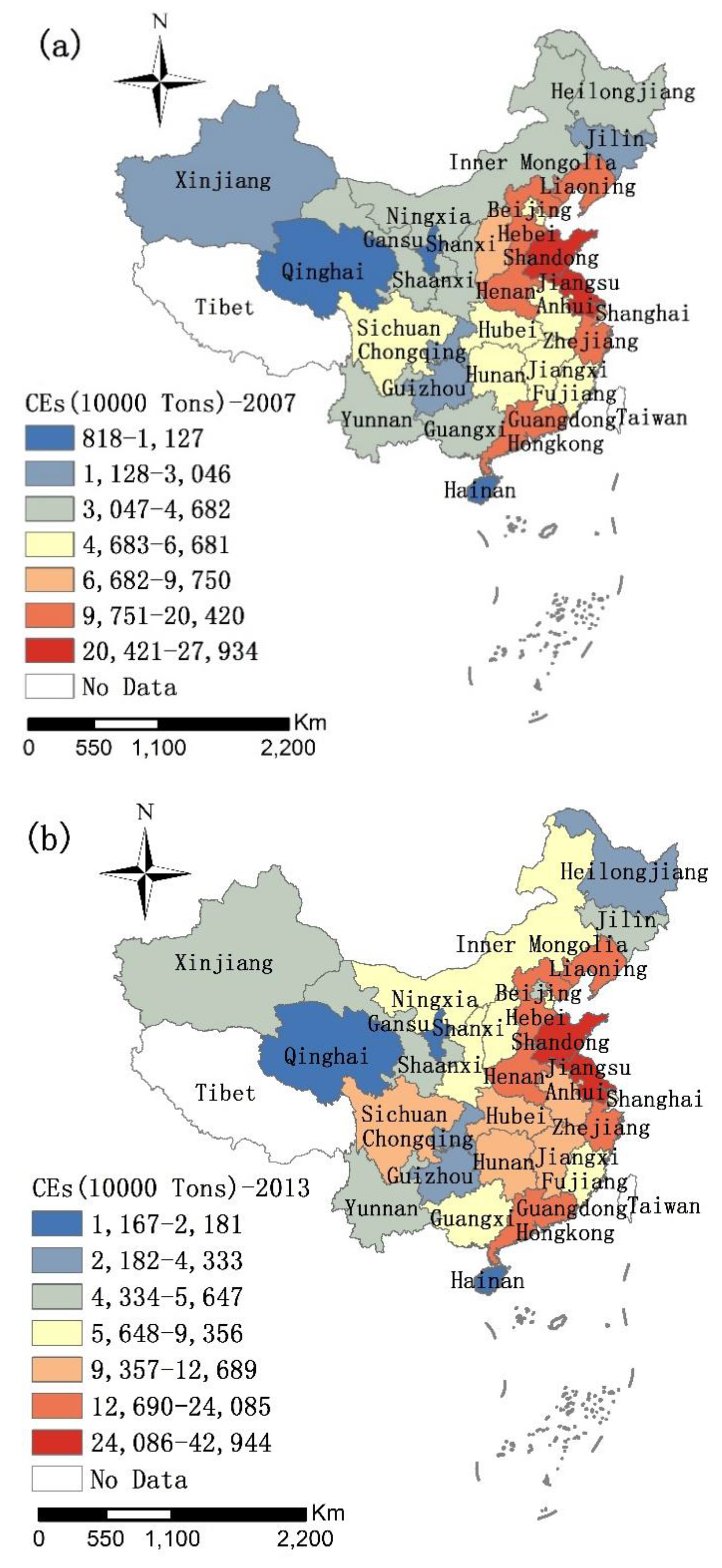

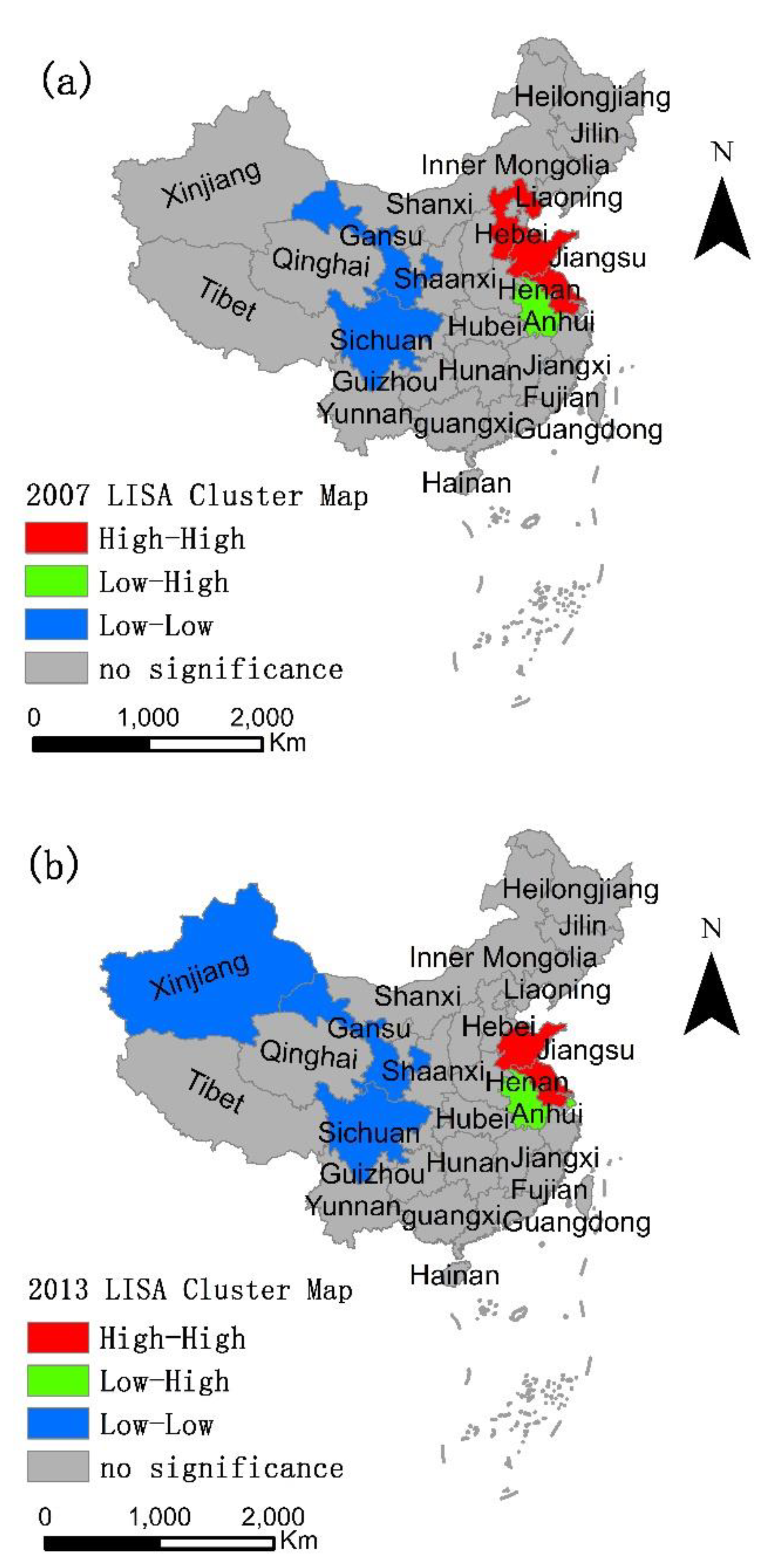
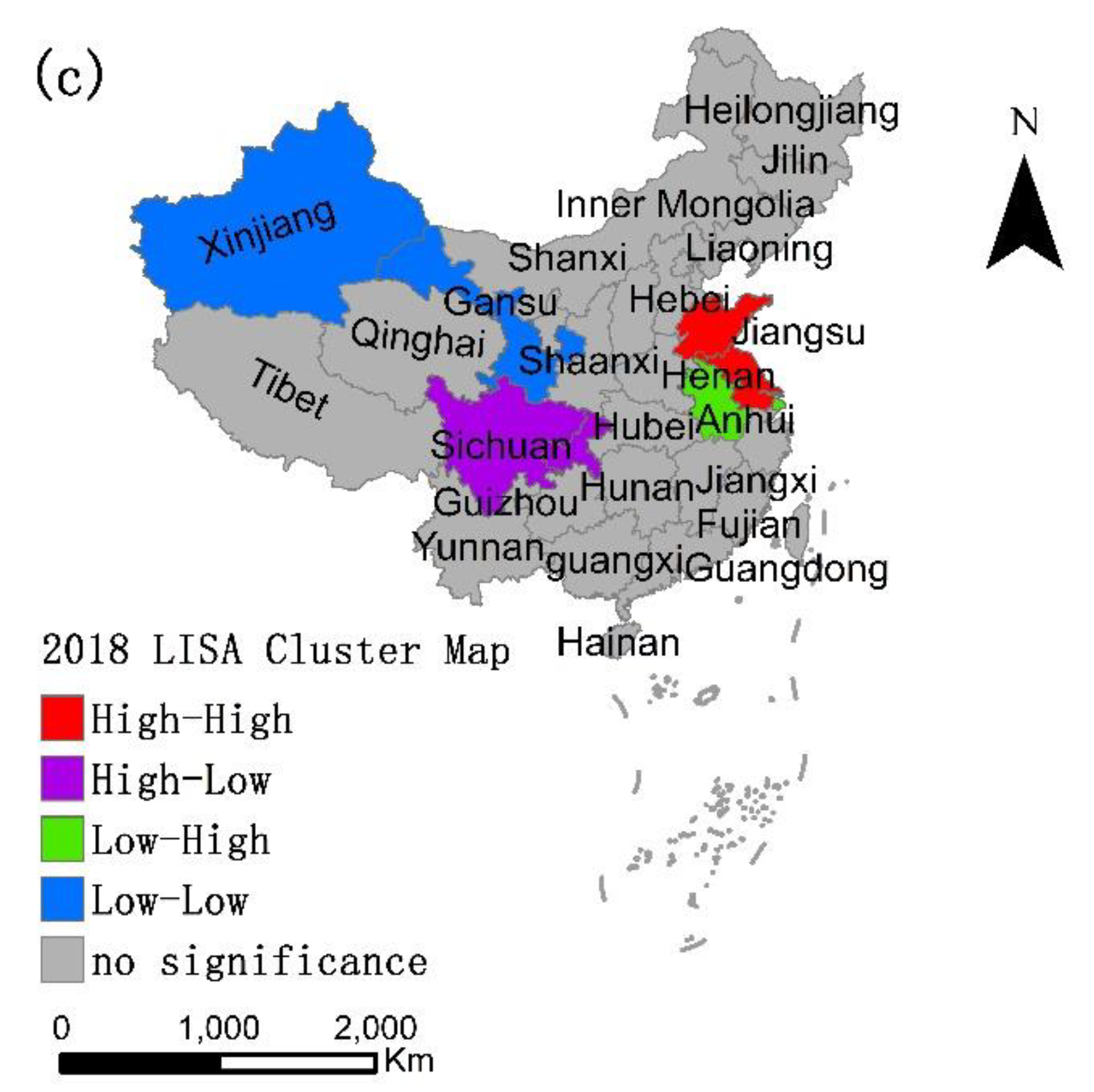
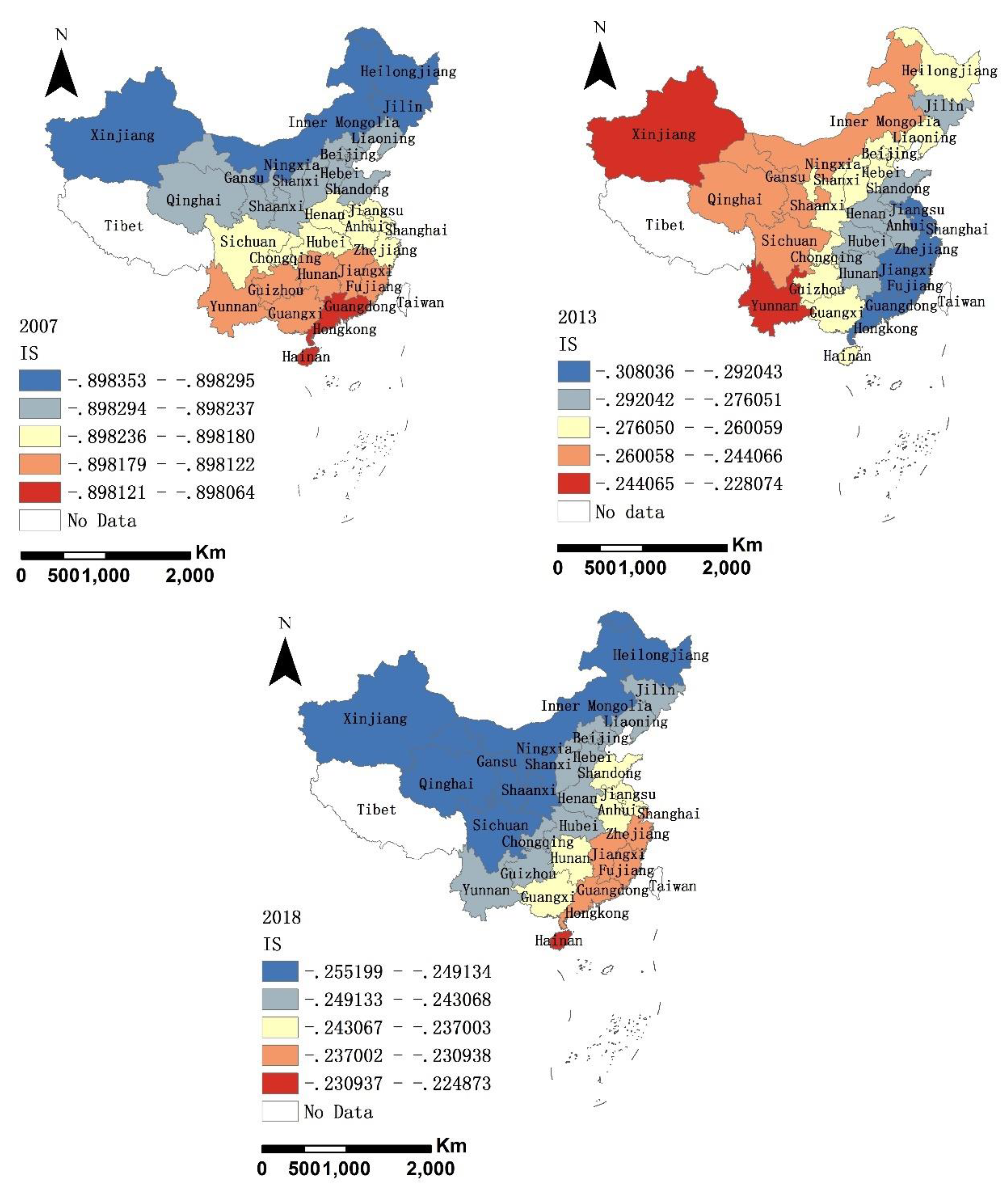
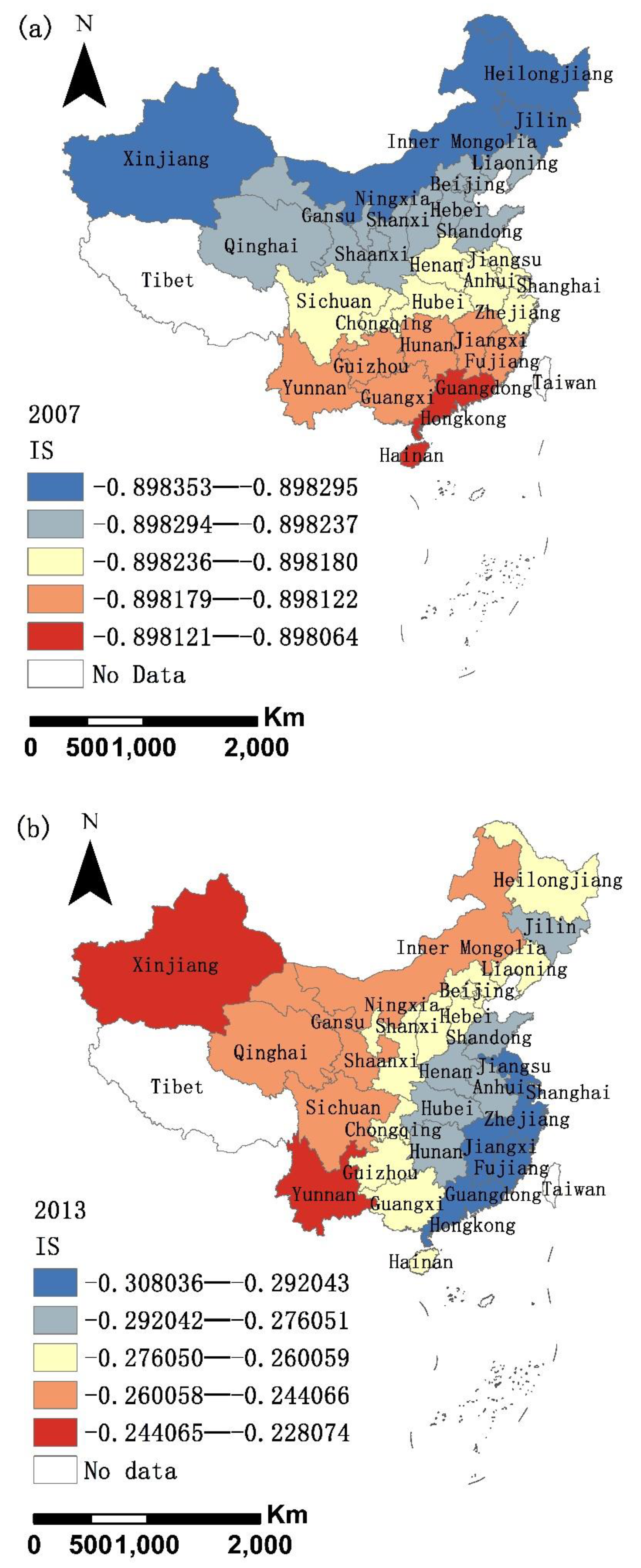
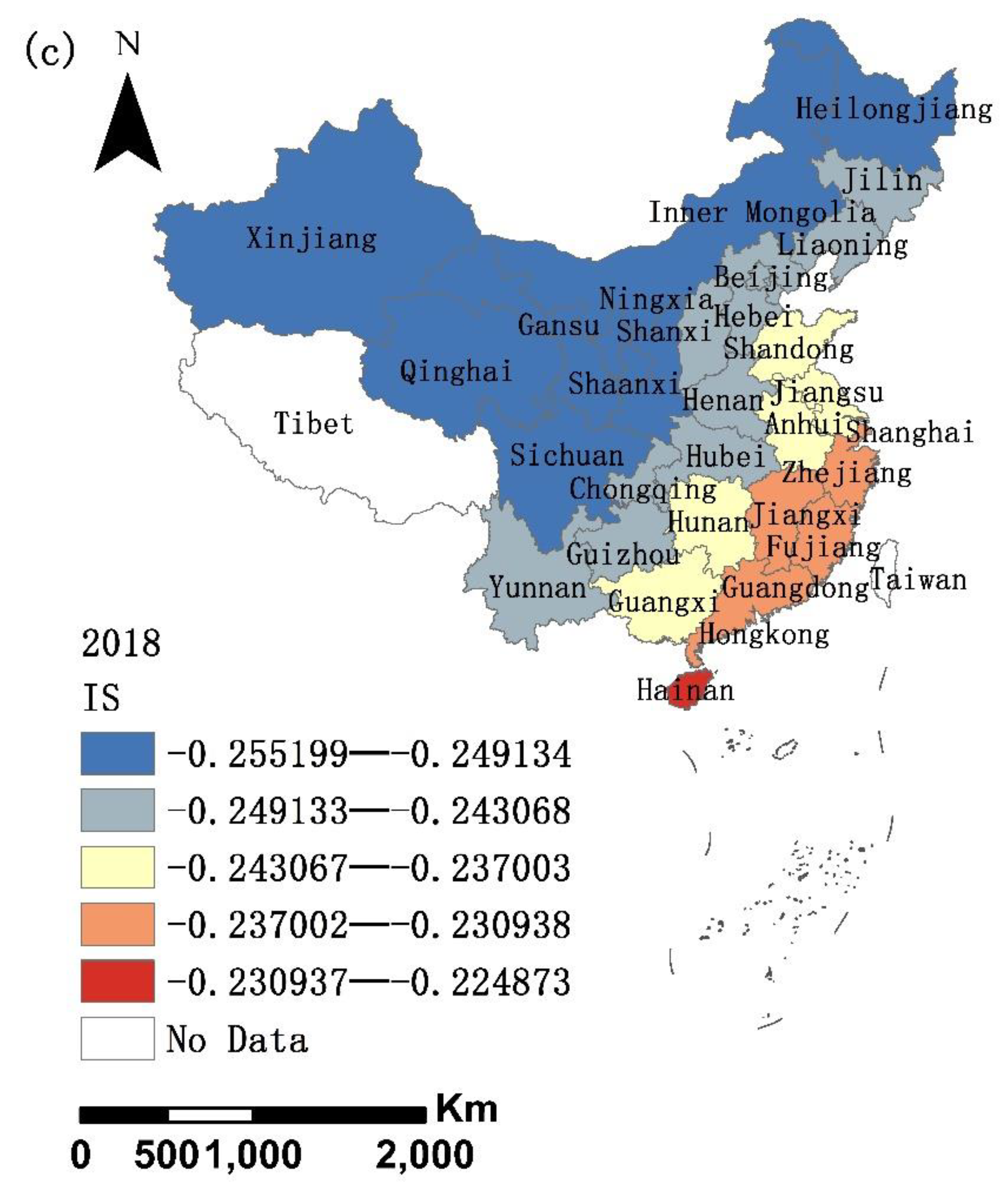
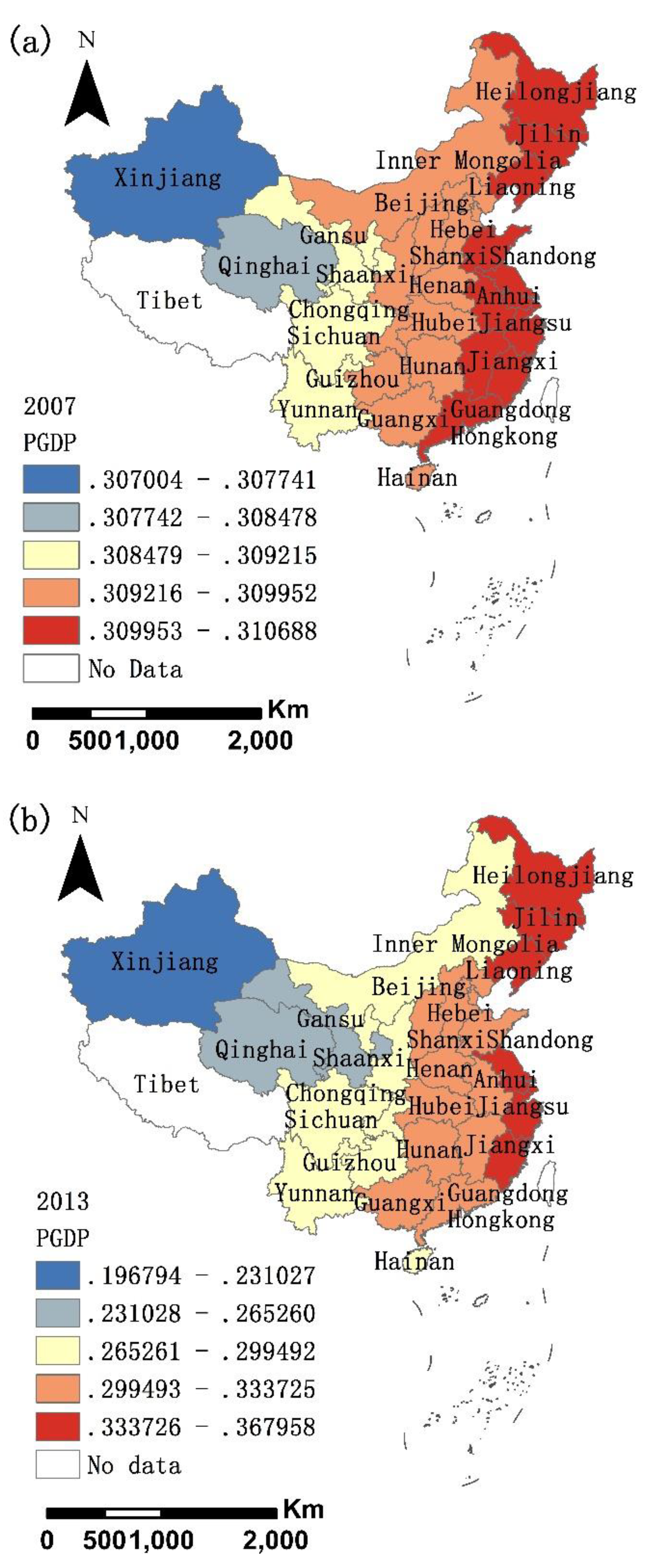

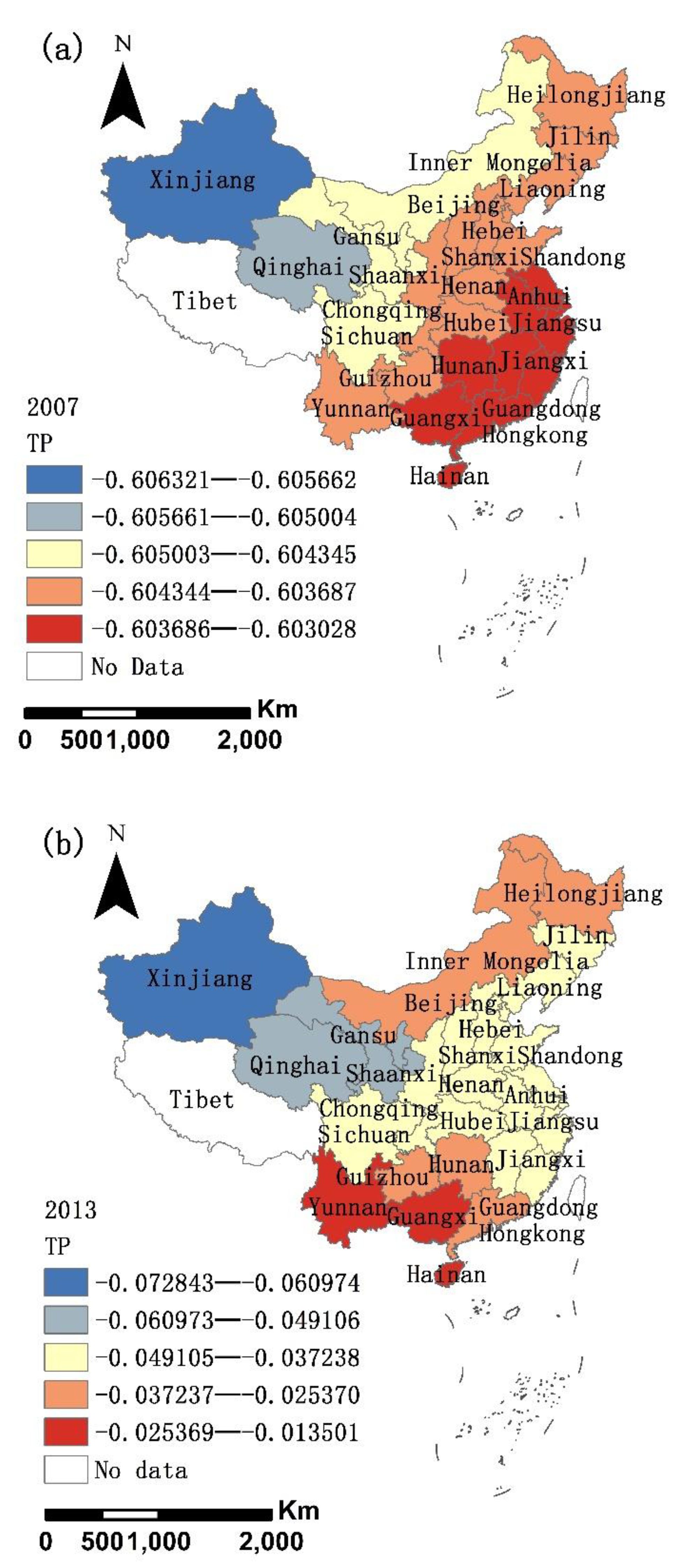
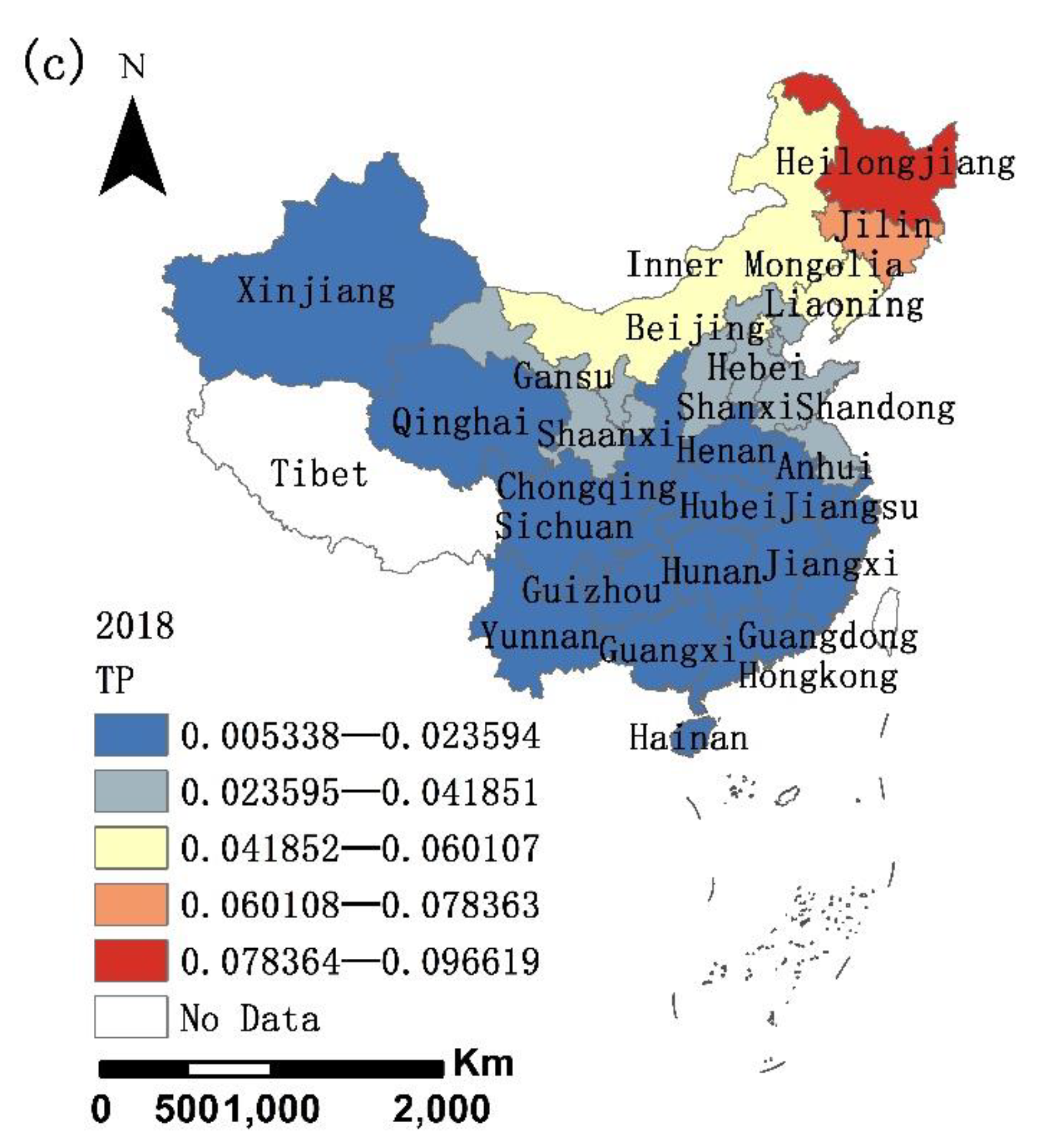
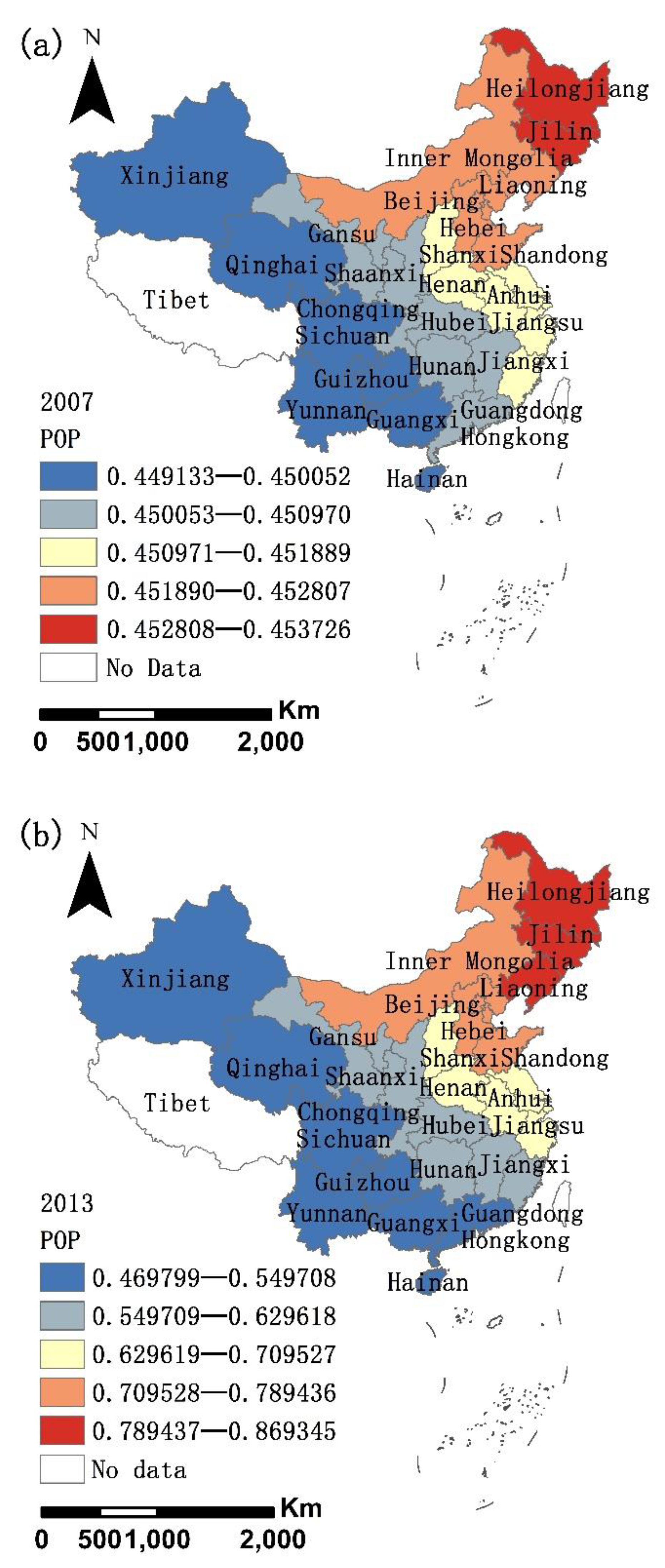

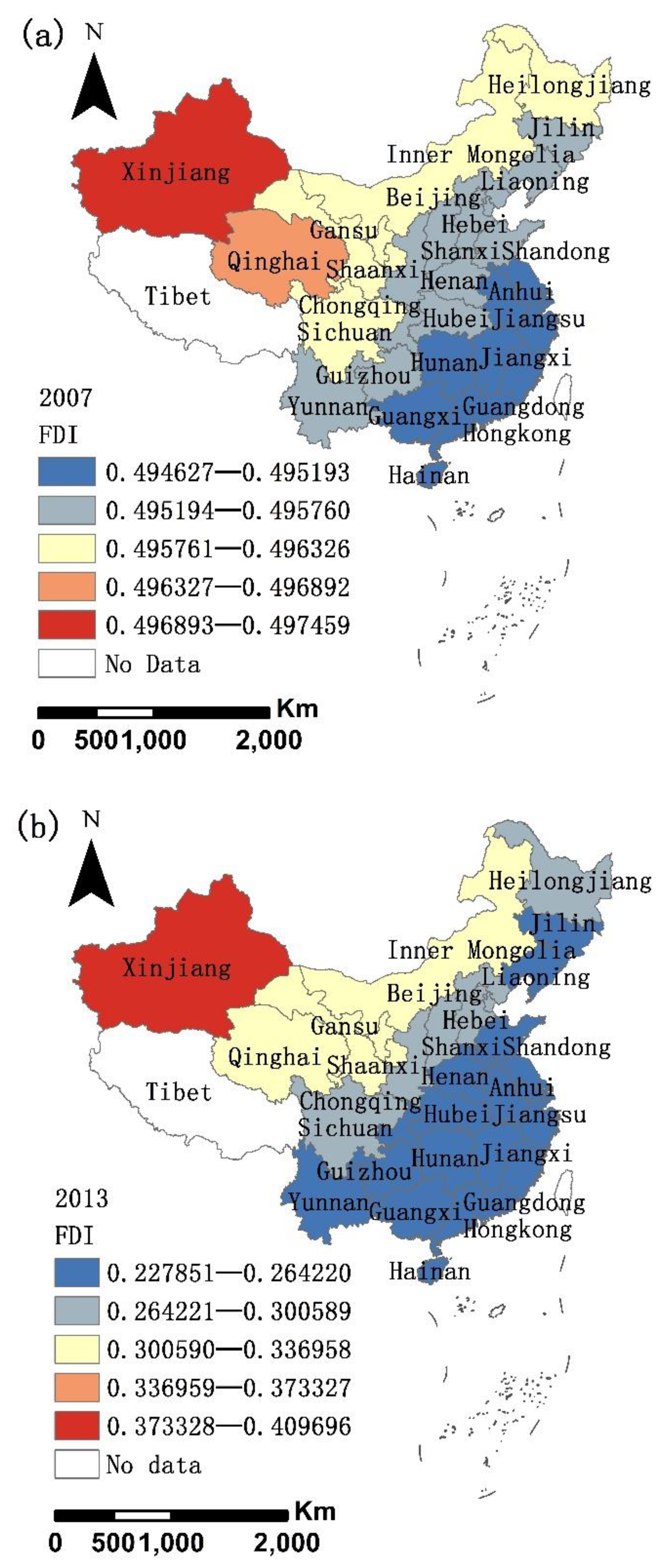

| Year | Moran’s I | Variance | Z-Score | p-Value |
|---|---|---|---|---|
| 2007 | 0.32135 | 0.018521 | 3.010372 | 0.001913 |
| 2013 | 0.328055 | 0.016367 | 3.175438 | 0.001437 |
| 2018 | 0.330209 | 0.010243 | 3.353327 | 0.001256 |
| Adjusted R2 | AICc | JB p-Value | VIF | Num. Vars. | X1 | X2 | X3 | X4 | X5 |
|---|---|---|---|---|---|---|---|---|---|
| 0.721 | −26.2 | 0.27 | 1.0 | 2 | PGDP | POP | - | - | - |
| 0.678 | −21.9 | 0.131 | 1.1 | 2 | UL | POP | - | - | - |
| 0.783 | −32.0 | 0.37 | 2.0 | 3 | IS | PGDP | POP | - | - |
| 0.734 | −25.8 | 0.13 | 1.2 | 3 | UL | POP | FT | - | - |
| 0.706 | −22.8 | 0.121 | 1.9 | 3 | IS | UL | POP | - | - |
| 0.829 | −37.2 | 0.521 | 3.0 | 4 | IS | PGDP | POP | FDI | - |
| 0.834 | −35.8 | 0.297 | 3.0 | 5 | IS | PGDP | TP | POP | FDI |
| Parameters | 2007 | 2013 | 2018 | ||||||
|---|---|---|---|---|---|---|---|---|---|
| Methods | GWR | OLS | GWR | OLS | GWR | OLS | |||
| Min. | Max. | Min. | Max. | Min. | Max. | ||||
| Intercept | 0.083 | 0.085 | 0.084 | −0.179 | −0.0111 | −0.065 | −0.188 | −0.058 | −0.136 |
| IS | −0.899 | −0.898 | −0.898 | −0.308 | −0.228 | −0.286 | −0.255 | −0.225 | −0.204 |
| PGDP | 0.307 | 0.311 | 0.31 | 0.197 | 0.368 | 0.302 | 0.28 | 0.431 | 0.384 |
| TP | −0.606 | −0.603 | −0.604 | −0.0728 | −0.014 | −0.037 | 0.005 | 0.097 | 0.063 |
| POP | 0.449 | 0.454 | 0.451 | 0.47 | 0.869 | 0.602 | 0.564 | 0.83 | 0.703 |
| FDI | 0.494 | 0.497 | 0.495 | 0.228 | 0.410 | 0.262 | −0.116 | 0.154 | −0.066 |
| R2 | 0.894 | 0.872 | 0.855 | 0.739 | 0.822 | 0.725 | |||
| Year | Variables | I | E(I) | sd(I) | Z-Score | p-Value |
|---|---|---|---|---|---|---|
| 2007 | residual | 0.018 | −0.035 | 0.117 | 0.388 | 0.335 |
| 2013 | residual | 0.058 | −0.035 | 0.111 | 0.856 | 0.185 |
| 2018 | residual | 0.047 | −0.035 | 0.094 | 0.074 | 0.211 |
Publisher’s Note: MDPI stays neutral with regard to jurisdictional claims in published maps and institutional affiliations. |
© 2021 by the authors. Licensee MDPI, Basel, Switzerland. This article is an open access article distributed under the terms and conditions of the Creative Commons Attribution (CC BY) license (https://creativecommons.org/licenses/by/4.0/).
Share and Cite
Yang, S.; Wang, Y.; Han, R.; Chang, Y.; Sun, X. Spatial Heterogeneity of Factors Influencing CO2 Emissions in China’s High-Energy-Intensive Industries. Sustainability 2021, 13, 8304. https://doi.org/10.3390/su13158304
Yang S, Wang Y, Han R, Chang Y, Sun X. Spatial Heterogeneity of Factors Influencing CO2 Emissions in China’s High-Energy-Intensive Industries. Sustainability. 2021; 13(15):8304. https://doi.org/10.3390/su13158304
Chicago/Turabian StyleYang, Shijie, Yunjia Wang, Rongqing Han, Yong Chang, and Xihua Sun. 2021. "Spatial Heterogeneity of Factors Influencing CO2 Emissions in China’s High-Energy-Intensive Industries" Sustainability 13, no. 15: 8304. https://doi.org/10.3390/su13158304
APA StyleYang, S., Wang, Y., Han, R., Chang, Y., & Sun, X. (2021). Spatial Heterogeneity of Factors Influencing CO2 Emissions in China’s High-Energy-Intensive Industries. Sustainability, 13(15), 8304. https://doi.org/10.3390/su13158304






